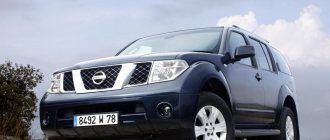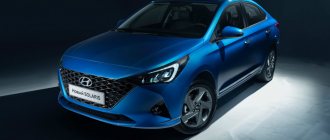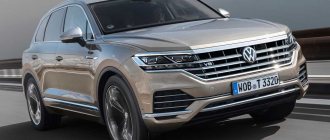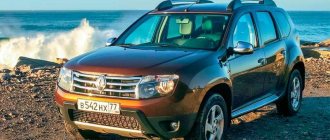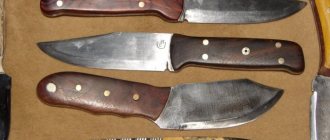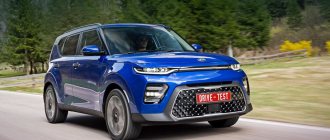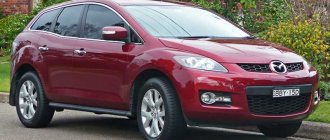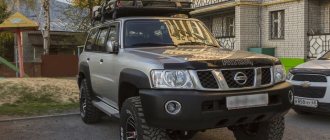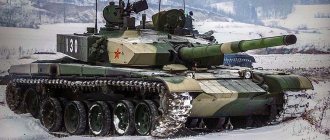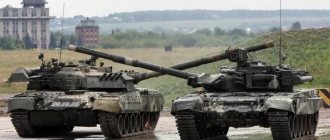The 2008 Volkswagen Touareg (1st generation), despite its excellent driving performance and comfortable interior, still could not surpass the BMW X5 in sales volumes in Russia. However, this does not mean that the crossover is not worthy of attention. Moreover, under certain conditions, buying a used Volkswagen Touareg can even generate income over time. However, when purchasing this model, you need to take into account that due to the abundance of built-in electronics, its maintenance will cost a large sum. But it is precisely this that ensures the most comfortable ride in almost any conditions.
Volkswagen Touareg 2008
Specifications Features
The 2008 Volkswagen Touareg can be purchased on the Russian secondary market only in all-wheel drive and with an 8-speed automatic transmission. At the same time, the German crossover has an extensive engine range, which includes the following units:
- 2.5-liter diesel with 163 or 174 hp;
- 3-liter diesel with 224 or 240 hp;
- 3.6-liter 280 hp;
- 4.2-liter 350 hp;
- 4.9-liter diesel with 313 or 351 hp;
- 6-liter 450 hp
For some time, the Touareg with a hybrid power plant was supplied to the Russian market. But the manufacturer quickly removed this version of the crossover from its lineup, since this modification was bought extremely rarely. It is impossible to say right away that all installed engines are problematic or reliable. Each of these motors begins to cause certain complaints over time. But, what is noteworthy, a number of defects affecting starting gasoline engines are eliminated for a relatively small amount. In particular, it is relatively inexpensive to restore the timing belt drive and fuel pump, which often annoy owners of German crossovers.
All diesel engines are characterized by increased sensitivity to fuel quality, rapid wear of expensive pump injectors and weak fuel injection pumps. In addition, crossovers with such units have a noticeable smell of burning fuel in the cabin. Gasoline engines have the following features:
- leaking front crankshaft oil seal;
- high fuel consumption (for top-end models it reaches 20 liters);
- weak timing chain drive;
- insufficient power of base engines.
One of the features of all power units is the absence of a dipstick for checking the oil level. This indicator is constantly reflected on the dashboard. But in the event of a breakdown of the on-board electronics, this feature turns into a clear disadvantage of the German model. The 3-liter turbodiesel is recognized as the most problematic among all engines. Moreover, breakdowns mainly occurred not in it, but in the fuel pump. Even the recall, which affected several thousand copies of the 2008 Volkswagen Touareg, did not correct the specified turbodiesel defect.
As noted above, all versions of the German crossover were equipped with an 8-speed automatic transmission. For the beginning of the 00s, this box was considered one of the best. But in practice it has not proven itself to be problem-free. Thus, with a mileage of only 50 thousand kilometers, car owners noted noticeable shocks when accelerating. In some cases, this drawback could be solved by flashing the electronic control unit. Also, automatic transmissions are characterized by early wear of solenoids, which have to be changed every 100 thousand kilometers. The service life of this box directly depends on the type of engine with which it is installed. The more powerful the engine, the sooner the automatic transmission has to be repaired.
Among all the shortcomings that characterize the German model, servicemen especially highlight the car’s suspension. The standard chassis periodically knocks during the first 100 thousand kilometers, regardless of the condition of the road surface. But the most problematic is the air suspension. Its main drawback is that the lining of the cylinders wears out over time, causing the crossover to suddenly tilt to the side. And this is not the most serious problem. The service life of the cylinders and compressor does not exceed 200 thousand kilometers (although they usually have to be changed earlier), and such parts cost about 400 thousand rubles. Therefore, service technicians insist that it is better to buy a used Volkswagen Touareg with a standard suspension.
Volkswagen Touareg I generation (2002-2010)
Now a used 4- or 5-year-old Touareg is about half the price of a “fresh” one. In terms of price, it competes with new SUVs. How advisable is it to buy a runaway “nomad”?
Story
The Volkswagen Touareg model is the company's debut in the class of expensive SUVs. Having no developments in this segment, Volkswagen used a separate 7L platform, on which the Porsche Cayenne and Audi Q7 are based.
Volkswagen TOUAREG I generation 7L was released in 2002. It became VW's first civilian SUV. The premium car had a choice of three petrol and three diesel engines, with power ranging from 174 to 450 hp.
Volkswagen Touareg II generation 2010-2014
Volkswagen TOUAREG of the third generation in Russia from the summer of 2021. There are no locks or lowering, it has finally become a crossover
The main feature of the Tuareg is its abundance of electronics, integrated into a computer network using the now familiar CAN bus and control server. The car's on-board electronics are responsible for almost all functions, which, combined with not the most advanced software, initially led to various problems. In this regard, the first generation Tuaregs are characterized by various floating “glitches” - spontaneous stopping of the engine while driving or rapid discharge of the battery.
When buying a used Touareg, we advise you to follow a simple rule - the simpler and newer the car, the more reliable it is.
Over time, a lot of improved “software” for various control units appeared, and official dealers regularly updated the “brains” of the car during routine maintenance.
In the case of the Touareg, a simple rule works - the newer and simpler the car, the more reliable it is. After all, the “basic” version does not have a complex air suspension and does not have many options, which after a few years turn into a source of headaches. In addition to cars purchased at car dealerships of official dealers in Ukraine, overseas Tuaregs are often found on the market. They differ from the “Europeans” in interior trim, lighting equipment and units of measurement - miles on the speedometer, and the radio receiver has an American frequency step.
Body
The body is resistant to corrosion - even heavily sandblasted copies of the first years of production have no traces of rust. However, the paint quickly becomes cloudy and rubs off during contact washing, which is why the car (especially black) somewhat loses its presentation. Polycarbonate headlights of pre-restyling versions are also covered with a cloudy “mesh” and often “sweat” inside, decorative headlight washer covers are often lost, and the washers themselves can leak.
The pre-restyling Tuareg was distinguished by rich equipment - full power accessories, dual-zone climate control, leather and wood trim... Traditionally for VW, this SUV has well-thought-out ergonomics, well-organized driver's workplace, high-quality materials and good sound insulation. However, cars from the first years of production bear the “stamp of time”: the plastic of the door panels is “worn” to the base, and the wooden linings crack. The Nappa leather seats are susceptible to wear, but the Cricket trim is more durable. In terms of space in the rear seat, the Touareg is quite comparable to its classmates; it does not have a third row of seats, making the trunk one of the most voluminous and comfortable. If the car was used year-round in a large city or the door locks and hinges were not lubricated during scheduled maintenance, there may be cases of jamming of the mechanisms, as well as “souring” of the windshield wiper trapezium. On Tuaregs of the first years of production, there may be problems in the operation of the factory alarm system due to poor contact in the door ends. On the first copies, many electronic bells and whistles failed - a rear view camera, a Keyless Access system (keyless access to the interior and to the ignition switch), four-zone climate control.
Engine
The “base” engine for the first generation Tuareg was a 2.5-liter turbodiesel. It is very sensitive to the quality of the oil - if you use a “left-handed” lubricant without VW approvals, accelerated wear of the CPG parts, as well as the cylinder head, is possible. Because of this, the engine may require repairs after the first hundred thousand kilometers.
This engine used pump injectors that were sensitive to fuel quality and often required replacement by 100 thousand km.
The legendary five-liter turbodiesel V10 with a power of 313 hp. With. “loves” oil, especially if it belongs to the long life category, and is capable of using up to three liters from replacement to replacement. Under heavy loads, the engine noticeably smokes, and due to the high torque, the transfer case on the copies of the first years of production required a “bulkhead” after several tens of thousands of kilometers (later it was strengthened).
Petrol six-cylinder engines with a volume of 3.2 liters are quite reliable, but over time they can upset their owner by stretching the timing chain and wear of the variable valve timing, which is why the phases “go away” and detonation occurs. The defect manifests itself as an extraneous “diesel” sound when the engine is running and an increase in fuel consumption, and to replace the chains it is necessary to remove the power unit. It is not uncommon for our fuel to have a failed fuel pump, especially if the owner has abused driving on a “dry” tank. More powerful 4.2 liter V-8 petrol engines are perfect for this car. However, it must be taken into account that the timing drive is carried out not by a chain, but by a belt, which, however, runs the planned 120 thousand km without any problems. At the same time, the engine is noticed to have an increased oil “appetite” - a consumption of 0.5 l/1000 km is considered the norm, especially if the driver likes high speeds and sharp acceleration. It is also important to know that the engine is essentially irreparable - the cylinder surface of the aluminum block has a special coating and does not require boring.
There are practically no statistics on 12-cylinder W-shaped power units due to their low prevalence, but in any case they are provided with an excellent fuel “appetite”. With proper maintenance, the least expensive versions to operate are the versions with a 2.5-liter diesel engine or a 3.2-liter V6 gasoline engine. In addition, transmission units in combination with these “engines” last longer than with more powerful ones.
Weak points of the car
- After a few years of operation, parking sensors may fail.
- The chrome plating on the exterior parts of early Touaregs sometimes peels off.
- Like the Porsche Cayenne, the body number is stamped in the trunk, near the spare wheel well.
- Temperamental drivers often “kill” automatic transmissions over several tens of thousands of km (relevant for powerful versions)
Transmission
Manual gearboxes are found only on basic versions with a 2.5 TDI engine. This box is quite reliable; over time, only the clutch parts may require replacement, especially if the owner has abused the load.
The automatic transmission of the Japanese company Aisin is not so reliable, which is especially true for cars of the first years of production. If you feel jerks when switching, you may need to “overhaul” and replace the hydraulic valve block. At the same time, official dealers practice replacing the expensive complete unit, which should be taken into account by those who like sudden starts from a standing start. “Drag racing” is contraindicated for the Tuareg automatic transmission - the transmission resource can be exhausted after 15–20 thousand km, which is typical for the most powerful modifications with V8 and V10 engines.
The Touareg is a serious SUV. Its high off-road potential is determined by the presence of a reduction gear in the transfer case, a center differential lock (both automatic and forced) and an optional rear cross-axle differential lock. The off-road arsenal includes an electronic EDL torque distribution system, and in some versions, air suspension, thanks to which the ground clearance can reach an impressive 300 mm. Thanks to this “set” of cross-country ability on serious off-road terrain, the Touareg, “shod” with “toothy” tires, is comparable to real Toyota and Nissan SUVs and significantly superior to the “parquet” ones - Mercedes M-Klasse and Infinity FX. The weak point of cars produced before mid-2004 is the transfer case. Due to a malfunction of the center differential lock servo drive, the clutch was not fully unlocked. At first, the manufacturer only recommended replacing the motor and updating the software, but a little later on the first Tuaregs they changed the transfer case assembly. If knocks and shocks occur in the transmission when starting and stopping the car, the cause must be sought in the suspended support of the driveshaft, and the official technology only involves replacing the “cardan” assembly.
Suspension
With frequent off-road driving or simply at high speed on bad roads, the stabilizer struts and ball joints of the front suspension quickly wear out, which lasts for 30–40, maximum 50–60 thousand km. Steering tips and wheel bearings, which experience increased loads due to the large mass of the wheels, will last up to approximately 70–80 thousand. Shock absorber struts and silent blocks in the lower arms will lose their effectiveness around the end of the first hundred thousand kilometers, but the rear multi-link suspension requires attention only after a very long mileage (over 150 thousand km).
The suspension is sensitive to even slight wear of rubber-metal elements, which causes the wheel alignment angles (both front and rear) to be disrupted. It is recommended to check the angles at almost every service (15–20 thousand km). If you neglect this, the tread of expensive wheels will disappear literally before your eyes over several thousand kilometers.
The Touareg is a serious SUV. “Shod” with “toothy” tires, it can be compared with the famous “rogues” from Toyota and Nissan.
One of the fashionable features of the Tuareg is air suspension, which is found on many cars. Over time, it begins to pass air through the injection valves located on each rack. Because of this, and also because of a failed body level adjustment unit, the body lowers to the lower position when parked, but after starting the engine, the pneuma restores its original ground clearance. It is best to immediately replace a failed valve or block, because when operating with such a defect, the compressor experiences increased loads and may fail. But the air cylinders themselves can last more than 100 thousand km without problems.
Steering
The steering is quite reliable, but on cars of the first years of production, power steering pumps often failed.
Bottom line
The first generation VW Touareg has many “childhood” diseases, but if the car has been serviced by a company service center and operated carefully, then it can last a long time. The main advantages of this car are its rich equipment and overall thoughtfulness. And if you add excellent dynamic characteristics with outstanding cross-country ability, it becomes clear why it is popular both in the primary and secondary markets.
The most profitable are versions with a 2.5-liter diesel engine or a gasoline “six”. Of course, a thorough diagnosis at an official service station is necessary - otherwise a car purchased at half price will “eat” tens of thousands of hryvnia in the first months of operation.
Features of the body and interior
A car like the 1st generation Volkswagen Touareg must have a comfortable interior and a reliable body. But, according to reviews from owners, it is the latter that they have questions about. The body of the German model has good corrosion resistance. Questions mainly arise from the fact that the car body begins to become outdated even with low mileage. After several tens of thousands of kilometers, the headlights of a German crossover become cloudy and the chrome parts lose their former shine.
The interior of the car also raises a number of complaints. The interior of the Touareg is finished with really expensive materials. But the quality of fastening the casing leaves much to be desired. The plastic that covers the front panel also begins to creak and become scratched relatively early. Another pronounced drawback that car owners pay attention to is the on-board electronics. Most often, the keyless entry system fails. But, according to reviews, problems can arise with almost any equipment. A number of car owners pay attention to breakdowns of power windows, others - to heated seats. In general, electronic defects rarely escaped the first generation Touareg.
Repair costs
The cost of servicing a German model is very difficult to calculate. This is partly due to the fact that the 2008 Volkswagen Touareg was produced with an extensive engine range, which included expensive engines. However, each engine, with proper maintenance and the use of high-quality fuel, lasts more than 300 thousand kilometers. One of the most expensive parts is the air suspension, the replacement of which, as noted, costs about 400 thousand rubles.
If you exclude mandatory maintenance costs associated with updating the chassis or engine lubrication, the Touareg is considered one of the most trouble-free cars in its class. It should be borne in mind that in the event of a breakdown, the purchase of most crossover parts will cost a large sum.
Options and prices (summary table)
| # | Equipment | Model years | Drive unit | Transmission | Engine, cc. cm | Acceleration from 0 to 100, s | Max. speed, km/h | Power, max., hp (kW) at rpm | Fuel consumption in the combined cycle, l/100 km |
| 1 | 2.5 TDI MT | November 2006 - November 2009 | Full (4WD) | Manual transmission 6 | 2461 | 12.7 | 180 | 163 (120) / 3500 | 10,3 |
| 2 | 2.5 TDI Tiptronic | November 2006 - November 2009 | Full (4WD) | Automatic 6 | 2461 | 13.2 | 175 | 163 (120) / 3500 | 10,6 |
| 3 | 2.5 TDI MT | November 2006 - November 2009 | Full (4WD) | Manual transmission 6 | 2461 | 11.5 | 188 | 174 (128) / 3500 | 9,2 |
| 4 | 2.5 TDI Tiptronic | November 2006 - November 2009 | Full (4WD) | Automatic 6 | 2461 | 11.6 | 183 | 174 (128) / 3500 | 9,5 |
| 5 | 3.0 TDI BlueMotion Tiptronic | November 2006 - 2008 | Full (4WD) | Automatic 6 | 2967 | 8.5 | 202 | 224 (165) / 3500 | 8,3 |
| 6 | 3.0 TDI MT | 2008 — 2010 | Full (4WD) | Manual transmission 6 | 2967 | 8 | 207 | 240 (177) / 4400 | 9,3 |
| 7 | 3.0 TDI Tiptronic | 2008 — 2010 | Full (4WD) | Automatic 6 | 2967 | 8.3 | 204 | 240 (177) / 4400 | 9,3 |
| 8 | 3.6 FSI Tiptronic | November 2006 - 2010 | Full (4WD) | Automatic 6 | 3597 | 8.6 | 218 | 280 (206) / 6250 | 12,4 |
| 9 | 4.2 FSI Tiptronic | November 2006 - November 2009 | Full (4WD) | Automatic 6 | 4163 | 7.5 | 234 | 350 (257) / 6800 | 13,8 |
| 10 | 5.0 TDI Tiptronic | November 2006 - November 2009 | Full (4WD) | Automatic 6 | 4921 | 7.4 | 231 | 313 (230) / 3750 | 11,9 |
| 11 | 5.0 TDI Tiptronic R50 | 2007 - November 2009 | Full (4WD) | Automatic 6 | 4921 | 6.7 | 235 | 351 (258) / 3500 | 11,9 |
| 12 | 6.0 Tiptronic | November 2006 - November 2009 | Full (4WD) | Automatic 6 | 5998 | 5.9 | 250 | 450 (331) / 6000 | 15,7 |
Review of Volkswagen Touareg 3.0 V6 TDI (2008)
Actually, I planned to start the review completely differently, but due to a certain reaction to the journal entry about choice and purchase, I slightly adjusted the text. Mainly because the first generation Touareg is a too controversial car. Did I understand this when making my choice? Actually yes. And, I won’t hide, there were doubts.
The fact is that about 15 years ago, one of my friends opened a service that specialized specifically in the segment of premium crossovers and SUVs - and I remember his ridicule of the Tuareg very well. And it was even more strange for me to find out that a man drove a first-generation Porsche Cayenne for 6 years and, having bought a car of the next generation, said that he was not entirely satisfied with it: they say that in many ways he liked the earlier model better.
Another friend, the owner of a 12-pot British Youngtimer, as a car for every day, unexpectedly purchased a V10 TDI and, apparently, is pleased: I don’t remember another car that he would drive for more than a year.
The late owner of a provincial car service center, who at one time impressed me with his unconventional approach to repairs and open-mindedness, did not want to get off the Tuareg (pre-restyling, 3.2) at all - and this picture, it turns out, is quite typical for people involved in the repair of VAG Group equipment...
And in general, there is not much negativity on the forums, not to mention the impressions of service station masters; in any case, much better than the horror films in Autoreview and some other publications.
So what should we do? What is the first generation Tuareg and is it worth connecting your life with it for a more or less long time? It was these questions that I began studying, trying to find answers. Therefore, if someone decides to repeat my experience, the following paragraphs will probably be useful.
Briefly the situation is this.
In 2002, Volkswagen released a car with a very meticulously designed mechanical part. It’s not that there were no weak points at all, but work was being done to correct the mistakes - and the childhood illnesses of the mechanics gradually went away. Things were even better with the bodywork. But what specifically let us down was the electronics. Now it is no longer so important what was the weakest link: crude firmware, poor insulation from moisture or defects in the blocks themselves - the point is that the owners of the first cars did not have to languish in idleness. Services struggled with problems as best they could, but they did so with varying degrees of success. As a result, the model’s reputation compared to its compatriots, not to mention its Japanese competitors, deteriorated considerably.
In addition, the guys from Wolfsburg did not waste time on trifles and decided to “shove the impossible” into their brainchild, making it as versatile as possible: for example, the air suspension allowed both “sticking to the road” at speed and “climbing on tiptoes” off-road, and the range and locking The central differential already in the base hinted at traction capability at the level of serious SUVs. So much so that some Tuareg owners took the hints seriously - and ended up disappointed. Not so in the experience of extracting a 2.5-ton carcass from a swamp, as in the resource of the chassis, which is clearly not designed for such feats on an ongoing basis. I’m already silent about how such adventures affected the contacts of the electronic transmission units and especially the air suspension systems and components. In general, the above experiments did not add any benefits to the car.
However, already in 2004-5, just before the launch of the series of “relatives” - the Audi Q7 and Porsche Cayenne - a serious revision of components, assemblies and firmware was carried out. The extremely successful V6 TDI of the BKS series went into production, the electronics stopped being ungodly glitches, and everything that could be protected from moisture received additional drainage, seals and sealant. According to the repairmen and operators I interviewed, starting in 2005, the Touareg got rid of a significant number of problems, and by that time the services had already become adept at eliminating them. By 2007, when the restyled version of the GP launched, and the three-liter diesel engine of the CAS series began to rapidly displace its ancestor on the assembly line, another technical revision arrived. I no longer remember the number of design changes announced by the factory, but I remember that the number in the technical bulletin impressed me. No one else made any significant changes to the design; the car was produced in the same form until 2010, until it was replaced by a model with the 7P index. Cars from the restyled series are considered the least problematic, although they all have their own nuances.
Let's start with the constructive ones. In principle, I would not consider gasoline engines for this model, although, if we ignore fuel consumption, the 4.2-liter V8 seems like a worthy option. 3.2 looks like a compromise in terms of power, although it is reliable; The 3.6 in this generation of the car was still struggling with childhood diseases, and the W-shaped 6-liter unit, although recognized as an engineering masterpiece, was already clearly redundant and served more as a demonstration of capabilities than a market model. Of the diesel engines, I was basically seduced by the golden mean: the five-cylinder unit with a volume of 2.5 liters is not only frankly weak for a car with a curb weight of much more than two tons, but also has in its design solutions that do not contribute to healthy sleep for the owner. These primarily include spraying of cylinders, which does not always reach the 100,000 km mark, as well as the notorious pump injectors costing 2,500 euros for 5 pieces. Very capricious, according to the owners of the five-cylinder Transporter T5 with the same engine. The mighty V10 with a power of 313 or even 350 horsepower seems much more convincing in terms of dynamics, but in its case the “handicap” of 750-800 Nm is the mandatory air suspension, fuel consumption worthy of a medium-duty truck, and a very unconvincing automatic transmission resource, not very then designed for “fun starts” with such nonsense. Well, plus the problems of the R5, only multiplied by 2... although the dynamic capabilities are truly fascinating.
The most popular in our latitudes remain the V6 TDI series BKS and CASA with a power of 224 and 240 horsepower, respectively, and a torque of exactly 500 Nm. There are exotic versions from other markets, with a capacity of 210-270 horses and with other traction parameters, but they are rare. The difference between the two diesel engines is exclusively in the firmware and fuel equipment; the hardware is basically the same. Many publications contain information that the earlier turbodiesel is practically omnivorous, but the C series engine is extremely demanding on fuel quality. In practice, apparently, the contrast is not so bright.
But these are, let’s say, flowers. Berries further. Let's say what all past and present owners without exception warned me about - it is highly desirable to find a car without any interference in the electronics. Here the question is no longer about the quality of components and factory design miscalculations, but about the qualifications of the people who carried out the intervention. To be fair, I note that this story is not only about the Tuareg. About 8 years ago, my godfather decided to replace the strange factory radio on the Passat B6, installing an Android device with a camera and navigation. As a result, I suffered with glitches from nowhere until I got the old “head” back.
Another important nuance is the presence of a hatch, or rather the lack thereof. Because at the first microcracks in the waterproofing, the first serious rain floods a number of electronic units.
What’s more interesting is that, according to repairmen, the air suspension after restyling is extremely reliable. And the demand for its components has given rise to a huge number of companies and small businesses engaged in the disassembly, repair, exchange, restoration and sale of compressors, receivers, racks, fittings and related small things. But the memories of the pneumatic jokes on the first copies made me rejoice at the fact that this particular example had a spring suspension.
And, finally, about him, or rather, about her (and this is definitely her). 2008 car, CASA engine (240 hp/500 N*m), spring suspension, non-alternative automatic transmission Aisin, Webasto without manual control unit (started by external temperature sensor at +4 Celsius and below), without hatch, electric drive of the fifth door, mounting systems in the trunk, with a basic Highline instrument panel with a monochrome red BC display, a basic Delta 7 radio, basic acoustics (not Dynaudio), the simplest version of exhaust pipes without nozzles, but with a dark gray interior with electrified and heated Nappa leather seats, all-round parking sensors and a sophisticated anti-theft system. The climate is the most common, two-zone, there are laminate inserts on the aluminum slats in the cabin, 17-inch wheels were installed from the factory, which were later replaced with 18-inch Manhattans. In general, nothing supernatural.
The main advantage for me personally was that more than half of the car’s operation took place before my eyes, and the owner compensated for the lack of technical knowledge with service at an official service center. I have no plans to continue this tradition, but I continue to keep a history of service (primarily for myself). During the first thousand kilometers, the chassis was inspected (they sentenced one axle boot, a strut strut and one ball joint “in order not to drive twice), the wheels were updated (the epic is described in the magazine, I won’t repeat it), an alignment was done and - finally It became clear how this car should drive in principle. And, most importantly, having assessed the car from different positions (driving, maintenance, minor repairs, additional services and, as some forum users like, “respect on the road”) and in different guises (driver, passenger, loader), I finally formed a more less reasoned opinion about this pepelats.
So:
1. Static.
Exterior/body. Nice, well made, impressive, for those who don’t know the year of manufacture, “expensive and boho”, if you like, but not a masterpiece. The advantage for me, subjectively, is that the chrome does not stand out against the background color (I’m definitely not a fan of it). And also, the dust is not visible. As for me, more massive bells for the exhaust pipes are requested (cutouts in the bumper mean). Due to the shape of the bumpers, the ground clearance seems greater than it is.
As for the execution, the metal is thick, galvanized (chips do not rust immediately and slowly), the front fenders are plastic, the hood is aluminum. The bumpers are strong: my wife managed to “catch” a metal column between the rear parking sensors, so the column suffered much more seriously than the bumper.
Interior/lounge. I'll start with what I DON'T like - I don't like the glossy wooden inserts of a disgusting reddish hue. Not enough to ruin the salon because of them, but enough to notice. They also say that the varnish layer on this veneer likes to crack and chip. There is already one small fire on the lid of the ashtray (it is not clear where from: both owners before me were non-smokers), the rest is better so far. There are already hints of abrasions on the edges of the window lift buttons, but not critical. It's not annoying yet. The buttons on the steering wheel are almost like new; they have probably been changed, or perhaps not used. There are crickets, but I was mentally prepared for the worst situation. It doesn’t bother me yet, so I scored accordingly.
The rest, in principle, does not cause any complaints: everything is solid, heavy, “weighty, rough, visible.” The plastic is very soft-look and not very soft-touch (I would even say, very not soft-touch), where it is not rubberized (rotary buttons), wood is wooden, aluminum-aluminum, steel-steel, leather-leather. It is clear that if they saved on materials, they did so very skillfully, and as a result it is not noticeable. Nappa leather is a neutral dark gray shade, soft, pleasant to the touch, but not slippery. True, it is easily scratched even by sharp denim fittings and even more so by any protruding keys and other sharp objects. However, I was warned about this. The instrument panel and controls are large, “masculine”, mostly analog and convenient. The contrasting red-blue backlight surprises at first, but does not irritate.
The trunk is really large, comfortable, and its shape is as close as possible to a regular parallelepiped. 4 x 18 discs in boxes fit with a margin. They would have fit in 20, but it would have been tight. The 4 assembled wheels have a chance to fit if you remove the curtain along with the roller blind body. 90% of the surface area is upholstered with carpet, the rest is plastic, which is scratched. On the left and right there are two niches where all the little things fit, including rags, napkins, first aid kits, on the floor there is a deflated stowage bag, to the right of it there is a factory set of tools (surprisingly, not quite a homeless package, there is even a transformable screwdriver and a key for 10), on the left is a tray covered with soft foam rubber for the air compressor, where I packed the wheel compressor and a can of sealant. There is space under the storage disc for a subwoofer; my car doesn’t have one; there is a piece of polystyrene foam and a clean rag, which is indispensable when changing wheels. The transformation is logical and elementary, with the rear seats folded down, a flat platform approximately 170 cm long is obtained (a 165 cm tabletop fits without problems), while a man in the prime of his life who dreams of losing weight rides comfortably on the left “half” of the rear seat (about 40%).
I'm pleased with the separately opening glass of the trunk door; this was not the case on previous cars; it turned out to be unexpectedly convenient. The loading height is barely higher than that of a passenger station wagon and lower than you would expect from a relatively tall car.
Now there’s a fly in the ointment - with a height of 185+ you are guaranteed to hit the open fifth door with your head. It’s good, at least the parts of the lock are hidden in the grooves and nothing threatens your head. For VAG this is truly an unfortunate miscalculation.
Ergonomics/comfort. The best that can be said is that it doesn't bother you. You sit neither high nor low, you can reach everything, everything is at hand. One of the few cars where I can adjust the seat to several fundamentally different, but equally comfortable positions. Usually one thing is convenient. Sometimes even less... Passengers are generally great, the rear seat is free, without adjustments, provides an ergonomically correct seating position and acceptable comfort on the road of any quality of surface, the front ones are equipped with a quite sufficient “gentlemanly set” of adjustments, including a very advanced lumbar support, with a roller moving in two planes. Except that the length of the pillow is not adjustable (although its length is objectively sufficient) and the back does not “break”. But there is also a fly in the ointment in this barrel of honey: the width of the side support bolsters of the pillow is not adjustable, and if in the hips and sides they are a couple of sizes “for growth” for me with a weight of about a hundredweight, then only a five-point belt will help more slender individuals))) But this is if you find fault and compare with the best examples of the world, so to speak, of cut and tailoring. But overall it's really good. Soft, comfortable, the back does not get tired, the lower back enjoys the support. My wife doesn’t even understand what I’m talking about...
Multi-stage heating is present in four places. An accidentally turned wheel seriously fried my back and thighs in a couple of minutes. I hope it will be just as effective in winter. But the resistance on the wheel, especially between positions 0 and 1, should have been made more clear.
A separate song is the instrumentation. After the scanty panels of modern crossovers, where besides the speedometer and tachometer there is no room for anything other than a fuel gauge and diode indicators for under-/overheating of the coolant, I have complete freedom. Dial gauges for oil and coolant temperature, a fuel gauge and even a voltmeter...there were more than that except for the Tahoe comrades. It’s all readable instantly; my old-believer “analog” brain perceives the information immediately. The BC screen displays information in bright red and pale red - surprisingly, it’s very easy to read. Despite the “collapse” of the console downward (just like on early Logans), information from the climate control unit is also visible normally, the blue backlight at night is not annoying (however, it is readable in the twilight so-so), especially since the temperature is comfortable and the Auto mode is I stay there all the time and don’t change.
By the way, about climate control. Here again I have to praise the Germans, because they seem to have managed to find the perfect balance of fan performance, air flow distribution and safety. Some family members have excessive sensitivity to wind and drafts; in the Tuareg it does not manifest itself even at maximum blowing speed. The performance of the air conditioner is sufficient, I will appreciate the stove in winter.
Service functions. I’m still getting used to the “scissor” - after all, most of my cars had a parking brake under the right hand. The rain and light sensors do not cause any complaints. Parking sensors are distinguished by a slightly strange operating algorithm, having a relatively short detection range and, in my opinion, color and sound differentiation based on distance to an obstacle that is not entirely logical. I’m already used to it, but - you can laugh - I liked the work of the parking sensors more on the Nissan Primastar. And they didn’t malfunction in the rain...
I like the ability to automatically adjust the rear wheel mirrors in parking mode - both the idea and its implementation were successful.
There are a lot of functions in the bookmaker’s menu - at the moment, more than half are simply irrelevant, but they were thought up competently.
The steering wheel...is normal. Four-spoke, with large, convenient buttons for cruise, BC control and heating. I was quite surprised by the presence of the latter; traditional morning frosts in October will show its effectiveness. I would like to have gear shift paddles on the upper spokes, but my configuration does not have them. And the shape of the steering wheel paddles is not entirely clear: as for me, if they were straight and positioned higher, it would be more convenient.
Visibility is excellent. The pillars are not too thick, the mirrors are “mugs”, a convenient function of reorienting the right mirror to the rear wheel when parking, photochromic interior - in general, everything is good, but... where would we be without a but))) The car left the showroom with tinted side and rear windows (high-quality and very strong), and with a specific windshield (maybe it’s an anti-reflective coating, or athermal glass), to which, apart from a couple of chips and abrasions, there are also no complaints, however, on a sunny day, with a certain incidence of rays, the instrument panel is reflected in it almost like in a mirror. It doesn’t bother me, but it misleads my wife. I'm still looking for solutions.
Sound. It’s hard to say for sure, because the basic audio system reproduces licensed and recorded CDs from FLAC quite well, while those recorded from MP3 and other compressed formats are noticeably worse. Anti-shock works great, even on our rather rough roads. I will probably install a USB interface on the changer output in the future, but this is not certain. The reception of the FM signal is not very good, but the terrain and the proximity of the warriors probably interferes. Overall, the sound is not inspiring, but not annoying either. There is no desire to improve it yet. Ergonomics of the radio is 5-. The downside is that it takes time to get used to the location of some controls.
What else is left...ah, “respect on the road”, as some people like. If we take the absence of illogical and threatening maneuvers on the part of surrounding road users as the main criterion of respect, then it exists, and, unlike black X5s and Range Rovers of the same age, it is more likely respect than fear. Apparently, the PL71 platform is not rated among scumbags. Even Cayenne)
2. In dynamics.
What is the main thing in dynamics? - so that it is enough. And since the engine and transmission are responsible for imparting torque to the wheels, it’s worth disassembling them like schoolchildren at an assembly.
At the time of its introduction, the engine was practically an exemplary diesel unit with good traction and fuel efficiency. As for the first, 240 forces and 500 Nm of torque from three liters and one turbine are still not bad today, but where the latest generation power plants have clearly succeeded is in economy. However, taking into account the specifics of operation, this parameter is within the acceptable range and does not hit the wallet too hard. With a not-so-vegetable driving in a city oversaturated with cars, you can fit in 13 liters per 100 km. In completely blind traffic jams named CoViD-19 - up to 18 liters. In city/suburb mode - +/-10. Driving “with special effects”, of course, provides for a “correction factor” of up to 1.5. But I don’t want to play pranks in my car, and the main reason for this is the automatic.
Having earned very flattering reviews about its service life and reliability, the Aisin TR-60 will never wait to win the title of driver's box. If you don’t take into account the imposing upshifts during acceleration, then the stubborn reluctance to switch to a lower gear when reducing speed and the equally manic desire to engage sixth gear already at 65-70 km/h (keep in mind the peak torque of 500 Nm at 1500 rpm) , reminded me a lot of a German preselective. Obviously, a group of Aryan gaijin, who localized the proud TR-60 SN into a product with an impersonal, military-smack index 09D, even then professed a strict ideology: everything for comfort, everything for economy! And if you don’t fall out of this paradigm, then even a box that has never known affection and has run under 200,000 km works like new. I mean, like a nearly new car, say, 2021, equipped with a six-speed automatic transmission from the same Japanese manufacturer. But if the driver suddenly forgot that it is not an ideologically verified product from ZahnradFabrik that is attached to the engine of his farzoig, but the very “product 09D”, then questions will certainly arise.
No, there will be no jerks (unless, of course, the box is thrown into the trash). Nor will there be an endless series of meaningless (and merciless) shifts, as on Fiat-Chrysler Group products with naturally aspirated engines and a nine-speed ZF automatic. And the howls of the Hound of the Baskervilles from under the transmission tunnel too. And the car will most likely still give out its passport 8-odd seconds in a burst of up to 100 km/h. But the time needed, say, for the transmission to understand at 80 km/h that overtaking has already begun and shift down at least two gears is a little annoying, especially if you have previously driven a car (or cars) equipped with ZF 8HP. Although, in fairness, both the speed and switching logic of the Japanese, impersonal with gaijins, are still more pleasant than that of its five-speed brother on the 2021 Fullback/L200...
Manual mode? - yes, it exists and works, although, to be honest, we have not yet been able to fully test it. But, spoiled by modern ergonomic solutions, I would still prefer paddle shifters to the need for longitudinal movement of the automatic selector in an additional groove.
Sport mode is definitely a panacea. The box immediately adjusts to the mode of maintaining engine speed above 2000 and the reaction to moving the right pedal acquires adequate sharpness and speed. But if this approach is adequate for country trips, then in the city it can be annoying.
In traffic jams, traffic jams and “lumbagoes” along the streets, driveways and goat paths of the concrete jungle, adaptability would come in very handy, but although it manifests itself, it is only sufficiently so that by the middle of a city trip, the algorithm that is convenient for me ceases to irritate my wife and vice versa. It stopped annoying and didn’t start pleasing. However, most drivers will consider this nitpicking. Especially if you have never tried either the unit I praised above from the gear factory in Friedrichshafen, or the live seven-speed automatic on the Stuttgart “Emel” or E-shke (there are plenty of them dead).
What’s good is that with an adequate assessment of the car’s capabilities (if you don’t confuse the second-generation Tuareg with the X5M) and road conditions, there is always enough dynamics, and what’s important is that it depends little on the number of passengers, terrain and wind direction. How, in my opinion, to use the capabilities of the power plant most rationally is described above.
Steering. I’ll start again with the fact that... this time I don’t dislike it as much as it requires getting used to: the steering wheel, as for me, is too light. Even at speed when it gets harder. My wife is happy, but I’m closer to the approach of another German concern with more effort on the steering wheel. However, the soft Goodyear tires are probably also to blame. However, I have no comments about directional stability (even on tires that have a “sin” in this regard), nor about the sharpness or informativeness of the steering. The maximum steering angle of the wheels is traditionally huge, as a result of which I am delighted with the maneuverability. True, when, after turning during acceleration, the wheels take a straight position, a change in camber angles is clearly felt on the steering wheel. On the same ML 320 CDI I tested, although directional stability, information content and maneuverability are by no means worse, this effect is less pronounced (but there the driver is, in principle, more distanced from the road).
Suspension. Conventional spring provides a good balance of controllability and comfort. On the ML W164 there is more comfort (especially on air, although there are no complaints about handling), on the X5 E70 there is more control - but comfort, especially on wheels with a diameter of 19 inches or more, is no longer quite enough.
If we take a break from comparisons, the suspension reacts most sensitively to sharp medium-sized irregularities: holes with torn edges, slab joints, large cobblestones on gravel roads, poor-quality patches on asphalt, etc. However, vertical accelerations do not reach uncomfortable values, but the choir of intellectual crickets immediately begins rehearsals. At the same time, sometimes absolutely monstrous coating defects with more or less smoothed edges are worked out absolutely calmly and almost imperceptibly. The car does not feel rutting (special thanks to the rubber), does not sway on waves, and does not “peck” excessively when braking.
Brakes. They are slowing down. Efficient and clear. The information content of the pedal is worse than that of most PSA models, better than that of most Japanese and approximately at the level of other Germans. The discs are still mostly alive, although certain signs of wear are already appearing; The mechanisms are visually in very good condition. A couple of fans are urging us to install Cayenne brakes. I’m holding on for now) From the subtleties - after changing the tires, the braking distance first lengthened, then, as the wheels were broken in, it shortened, but the main thing is that the process became smoother, predictable and comfortable. For the first moment, it seems to the passenger that the car is not slowing down at all - and now it is already standing still. The driver, of course, is aware of what is happening. We'll see what happens on the spikes in winter.
Stabilization system. As if there is. So far I haven’t felt its work: either I drive carefully, or it works so unnoticeably. I hope it's the first.
When cornering dynamically, oversteer is very noticeable: on Achilles tires the car turns sharper, on Goodyears it turns more intelligently. If we live to see ice and snowfall, I’ll try to draw organizational conclusions. In general, it sets a moderate driver's mood, without imposing any particular driving style. In this and many other things, the old Touareg is a car for everyone: you can drive sedately and sedately, or you can drive quite dynamically and quite quickly. And it’s always comfortable and with pleasure.
Acoustically, the interior is well insulated, although, as I already mentioned, there are crickets. I heard completely different opinions about Shumka, but I came to the conclusion that it is not bad. The weakest point is the wheel arches, and if the tires themselves are not noisy, there is a chance to move in relative silence: the engine is clearly audible only in the right semicircle of the tachometer, aerodynamic noise does not appear up to 100 km/h and is not annoying at higher speeds , despite the large mirrors. With the radio barely purring, I didn’t hear the siren of the police car; Luckily, I saw it in the mirror and managed to change lanes to the right.
Patency. As you know, there are three types: geometric, traction and... psychological. I'll start with the worst parameter, i.e. with the last one: bad! Firstly, there is unpainted plastic only on the bottom of the bumpers and doors, which means it’s simply a shame to scratch the car. Secondly, with the slightest load, the carcass pulls a good 2.5 tons - and after some experience in conquering serious off-road conditions on frames of various calibers, you understand that without tracked vehicles it will be expensive to drag this behemoth out of the swamp. But, to be honest, even for non-extreme off-roading there is a frame pickup truck, and all that is required of the Tuareg is to take it out in heavy snow, park without loss in a parking lot uncleaned from winter precipitation, or drive to the village for a traditional Christmas dinner, regardless of the quality of the work of the road workers.
Geometric cross-country ability is not bad: the ground clearance is visually greater than the declared 200 mm, comparable to the parameter of a Fiat on large wheels (23-24 cm). Maybe it just seems so, I haven’t played with the ruler yet. The angles of approach, departure and ramp are adequate for a car that is not intended for constant use outside of hard surfaces and hint that, in principle, you can drive off these same surfaces and come back without loss. Considering the model of summer tires I have chosen (and this, let me remind you, is Goodyear F1 Eagle Asymmetric SUV), it is easy to guess that I am definitely not going to abuse this opportunity. However, we have one place under the bridge that turns into a ford (or a bathtub in military terminology) after any decent rain. So, this ford is overcome very confidently; the X1 following behind stalled and probably caught a hydraulic shock before reaching the middle. As for the articulation of the suspensions, the axle crossing angles are significantly better than those of any passenger car or SUV, but significantly worse than those of a frame pickup truck with the same ground clearance.
Traction ability promises to be good, at least the presence of a center differential lock and low gear is very reassuring. However, the maximum requirements for cross-country ability are set out above - and for such “feats” both the range and center blocking seem redundant.
For the most curious, guys with a lack of adrenaline in the blood and adventures in life have shot and posted enough videos on YouTube.
Light. Bi-xenon, common on later 7Ls, with AFS cornering light system. While the daylight hours are relatively long, and the trips are mainly on illuminated city streets, I don’t draw any conclusions. Night, rain, winter, highway - they will show you. For now I can only say that the cornering light system is indispensable for inexperienced drivers. Although it is very convenient for those who have exchanged hundreds of thousands of km. I'm waiting for a test drive of the third Tuareg with matrix headlights to compare.
3. Service. When buying a car at such a tender, teenage age, it would be nice to estimate the upcoming maintenance and possible repairs. I figured it out.
What to say? — VAG has always been distinguished by its humane attitude towards people involved in the maintenance and repair of their equipment. Everything that is included in at least some inspection, maintenance, repair or replacement regulations has relatively easy access and an understandable operating algorithm. Anything that does not provide for accommodation during operation is expectedly worse.
I foresee a question about the cost of spare parts and consumables. The figure is not scary, largely due to the presence of a huge number of substitutes and contract units with a guarantee. It turns out to be no more expensive than the average budget crossover; however, it is somewhat more troublesome. At least in terms of running gear consumables it is no more expensive than Renault/Nissan and significantly cheaper than Subaru.
4. General perception. The main exploiter, for whose sake everything was actually started, is delighted. The car fully lives up to its expectations and hopes. In some places it is superior.
It’s much more difficult to generate a stream of “pink snot” and laudatory epithets, but overall, in my little experience so far, the Volkswagen Touareg typ PL71 GP is a much more successful car than is commonly thought. If we talk about subjective perception, then this model evokes somewhat strange sensations.
Firstly, the car is perceived as absolutely analog, old-believer, iron, akin to the large Audi of the late 90s - although, in fact, it is no longer such. All service electronics do not try to push or remove the driver from control, as has become common now: this is true both in relation to control and measuring instruments that provide comprehensive information about the state of the main systems (and allow you to track trends, and not state the fact of a collapse), The same applies to the management process itself. Sitting behind the wheel, you understand that it is you who are driving the car, and not the security systems that allow you to do this. Moreover, they do not try to dictate to you exactly how to lead. And the design component does not particularly limit the choice of destination.
Secondly, you can drive like a retired botany professor, or you can “play checkers” on the road, you can wear a suit and a Swiss watch, or you can wear moccasins, shorts and a G-Shock, you can go to a business meeting or from fishing, — the machine is absolutely universal and organic in every role.
Thirdly, for those who crave a feeling of premium, breed, it is there. Only this is not a prim aristocrat, whose quirks should be perceived with delight, and whose name should be pronounced with aspiration, but the history of each defect, be it a crooked seam (even a welded one), glitchy electrics or ergonomics for chimpanzees, should be passed off as “loyalty to traditions”, “historical heritage” and an indispensable attribute of belonging to high society; This is a guy from a simple family with a worker-peasant surname and origin. He doesn't try to hide them or pretend to be someone else. He's honest. He is well aware that they will not buy him for his name (it’s too bad the surname is not a noble one), or for his history (so-so history: from Kubelwagen to Iltis, including Typ 181), or for anything other than his personal qualities. And here we already have something to show.
Total.
Considering the 3 thousand km traveled in 3 months, I consider the purchase of a specific car in specific conditions to be an absolutely correct decision. Is it worth repeating my experience? Let everyone decide for themselves. But, when making this decision, it would be nice to rely not on the myths of “experts” and the epic of garage cooperatives, but on facts, and familiarize yourself with the features of the model in advance - then there is every chance of getting a still quite strong copy for the price of a slightly fresher one, but already dented by someone - Tiguan, Rogue, CR-V or Rav-4. And if you don’t take into account frankly outdated multimedia and other “checkers”, and put “going” at the forefront, the old horse will not only not spoil the furrow, but will also easily plow a new one where the cohort mentioned above simply cannot reach. Yes, the downside to “driving” is higher operating costs and not the most modern design. But here, as they say, to each his own.
That's all I have for now.
Alternative choice
Instead of the 1st generation Volkswagen Touareg, you can purchase the following cars:
- Toyota Land Cruiser Prado;
- BMW X5;
- Audi Q5;
- Infiniti QX70.
Land Cruiser Prado in comparison with Touareg may not seem like the best choice. This is largely due to the fact that both cars are approximately comparable in quality and reliability. But a Japanese crossover on the secondary market costs about 2 times more than a German one. Perhaps the Land Cruiser Prado performs better off-road. However, such a large overpayment for the Japanese model is not justified in practice.
The BMW X5 will also cost more than the VW Touareg. The Bavarian model, in principle, is more popular in Russia, which explains the difference in price. The BMW X5 also surpasses its competitor in terms of acceleration dynamics. But otherwise, the differences between these models come down to personal preferences. We can only note the fact that the BMW X5 demonstrates better fuel efficiency on the highway and in the city.
Of the models presented above, the Audi Q5 is more suitable for comparison. This model, like the Touareg, is relatively available on the secondary market. It is characterized by many of the shortcomings that appear in a crossover from Volkswagen (in particular, problematic electronics). But the Audi Q5, like the BMW X5, is more dynamic and more economical than its competitor.
The Infiniti QX70 was released later than the Touareg version in question. But even this circumstance does not give the Japanese model a noticeable superiority over the German one. The Infiniti QX70 is more focused on urban use, which is partly reflected in its enviable dynamics. The Touareg has the best off-road capabilities. In terms of reliability and workmanship, both cars are approximately equal to each other.
